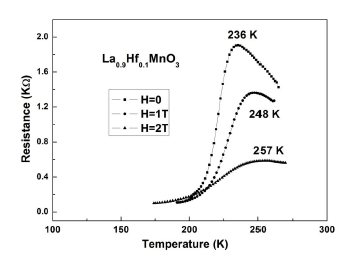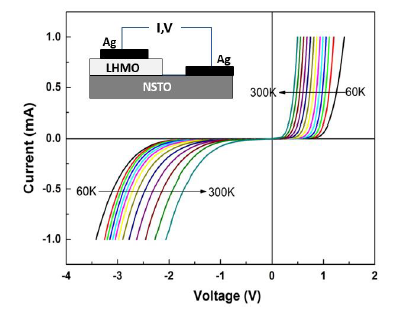 Mini Review
Mini Review
Thin Films and Heterojunctions Composed with Electron Doped La1-XHfxMnO3 Manganite
Liu Yunyun, Huang Chuanxin, Wang Junbao, Wang Meng, Zhang Bin, Zheng Yanbin, Tian Zhongjun, Jia Jikui, Lv Yiying, and Gao Ju*
School for Optoelectronic Engineering, Zaozhuang University, Zaozhuang, Shandong, 277160, China
Gao Ju, School for Optoelectronic Engineering, Zaozhuang University, Zaozhuang, Shandong, 277160, China.
Received Date: August 19, 2022; Published Date: August 25, 2022
Abstract
All oxide heterojunctions have been fabricated with electron doped La1-xHfxMnO3 manganite. The sole tetravalent state of Hf4+ ensures a n-type conductive mechanism in La1-xHfxMnO3 manganite. La1-xHfxMnO3 /Nb-SrTiO3 heterojunctions were fabricated. These junctions showed excellent rectifying characteristics in a wide temperature range. Their transport properties are tunable electrically and magnetically. Such heterojunctions may be of potential in developing functional field-effect transistors of manganites.
Keywords:Heterojunctions; Manganite; Field effects; Thin films
Introduction
Most perovskite manganite’s are known as p-type conductors which showed variety of features such as colossal magnetoresistance (CMR) and electro resistance (ER) effects [1-5]. A few cases of n-type manganite, substitution of tetravalent ions (e.g. Sn4+; Ce4+; Sb4+; Te4+) for trivalent La ions in LaMnO3 were reported [6-8]. However, there are also arguments on whether it is intrinsically n-type conductive mechanism in these systems due to the existence of multi-valence of these doping elements. To prevent such problems, we tried to dope tetravalent hafnium ion (Hf4+) into manganite oxides to form the n-type manganite [9,10]. The sole tetravalent state of Hf ensures a reliable n-type conductivity in La1-xHfxMnO3 (LHMO). XPS and Hall measurements confirmed that a mixed Mn2+/Mn3+ state was formed in LHMO film, implying an electron-type conductive mechanism. We further fabricated heterojunctions composed with such a n-type LHMO and Nb-SrTiO3 perovskites.
Heterojunctions were formed by growing LHMO on single crystal of 0.05%Nb-STO (NSTO) using pulsed laser deposition [11-13]. Excimer laser operated at KrF model with a wavelength of 248 nm was employed. The laser frequency was 2 Hz and output energy density were ~2 J/cm2 [14]. During the deposition the substrate temperature and oxygen pressure were kept at 700 ℃ and 0.5 mbar, respectively. To avoid possible deficiency of oxygen, the as-grown films were in situ annealed in pure oxygen of 1 atm for a duration of 30 min [15].
The phase structures and epitaxy of the heterostructures were investigated by X-ray diffraction (XRD) including θ-2θ scan and rocking curve measurements [16]. No reflections from the randomly oriented gains and secondary phases like HfO2 were visible, implying that the grown films were of single phase. Rocking curve of the (002) reflection presented a very small value of the full width at half maximum, typically <0.2 degree, indicating a highly epitaxial growth and excellent crystallinity. XPS studies show that the binding energies of the 4f-Hf are nearly identical to the 4f binding energies of HfO2 and are ~2 eV higher with respect to that of Hf-metal. It clearly reveals that the Hf ions are indeed tetravalent in LHMO film. Similar to those p-type manganite’s, the electron-doped LHMO also demonstrated colossal magnetoresistance (CMR) effect (Figure 1). When the sample is placed in a magnetic field of 2 T, the peak resistance decreased remarkably, leading to a MR~-40% (defined as MR= [RH-R0]/RH 100%). Meanwhile, the M-I phase transition shifted to a higher temperature. Such observations are quite similar to those observed in hole-doped LaMnO3 manganite’s, implying a change of magnetic and electronic structure of LHMO in magnetic fields. It shows that the CMR effect is a common feature for both p-type and n-type manganites.

A typical resistance-temperature dependences for a thin film of LHMO with or without magnetic fields is shown in Figure 1. In the absence of a magnetic field, a metal-insulator (M-I) phase transition took place at ~236 K (Figure 1). Such a M-I phase transition is believed to be close to the PMI-FMM transition temperature (Curie temperature TC). The R-T curves of this sample in presence of magnetic fields (B = 1, 2 T) are also presented in Figure 1. The M-I transition temperature TC increases from 236 K to 257 K as the magnetic fields increases from 0 to 2 T. The maximum value of magnetoresistance [MR% = (R0-RH) / RH × 100%] under a magnetic field of 2 T is 303% (as can be seen in Figure 1). The results show that the CMR effect is also a common feature for the n-type manganite [17].
We found that the M-I phase transition can be greatly affected by oxygen deficiency. The MR-T dependence (H = 9 T) for as-grown and annealed LHMO films are shown in Figure 2. The value of MR [We define the magneto resistance as MR = (R0–RH)/RH×100%] at the Curie temperature is 350% and 520%, respectively. It clearly reveals that the post-annealing can enhance the CMR effect, indicating the influence of oxygen deficiency. Similar phenomena were also observed in other doped manganites. The inset of Figure 2 shows a typical X-ray diffraction spectrum.

The current-voltage (I-V) dependences of the LHMO/STON heterojunction at different temperatures are presented in Figure 3. We defined the positive bias for a current flowing from LHMO film to STON substrate. TheI-V curves presents a good rectifying behavior for temperature from 60 to 300 K. The observed I-V relation mimics that of conventional bipolar junctions. The breakdown voltage (Vb) and diffusion voltage (Vd) increase monotonously as temperature is decreased, indicating that the junction resistance (Rj = V/I) depressed as the temperature increased. These are similar to the previous studies on the manganite-based heterojunction. At this moment detailed mechanism for manganite-based heterojunctions is still unclear. Previous studies indicated that the I-V relations and transport of these heterojunctions may be interpreted with model of a p-n junction or a Schottky junction, i.e. the thermionic emission mechanism. More systematical investigations of the n-type LHMO-based heterojunctions could benefit our understanding of manganite compounds and promote the application of such heterojunctions.

In summary, thin films and heterojunctions of Hf4+ doped LaMnO 3 manganite have been fabricated and investigated. Such n-type LHMO also showed remarkable CMR effect and M-I phase transition. The oxygen deficiency may play an important role for their CMR effect and phase transition. Heterojunctions composed with the n-type LHMO demonstrated excellent rectifying characteristics.
Acknowledgment
This research has been supported by the National Natural Science Foundation of China (Project No. 11974304), the Natural Science Foundation of Shandong Province (Project No. ZR2020QE034).
Conflict of Interest
No conflict of interest.
References
- H Takagi, HY Hwang (2010) An emergent change of phase for electronics. Science 327(5973): 1601-2.
- ZG Sheng, J Gao, YP Sun (2009) Coaction of electric field induced strain and polarization effects in La7Ca0.3MnO3/PMN-PTstructures. Phys Rev B 79: 174437.
- V Markovich, G Jung, Y Yuzhelevskii, G Gorodetsky, FX Hu, et al. (2007) Metastable resistivity of 8Ca0.2MnO3manganite thin films. Phys Rev B 75: 104419.
- J Gao, SQ Shen, TK Li, JR Sun (2003) Current-induced effect on the resistivity of epitaxial thin films of La7Ca0.3MnO3La0.7Ca0.3MnO3and La0.85Ba0.15MnO3. Appl Phys Lett 82(26): 4732.
- J Gao, FX Hu (2005) Statistical mechanics characterization of neuronal mosaics. Appl Phys Lett 86: 092504.
- J Gao, SY Dai, TK Li (2003) Electronic structure: wide-band, narrow-band, and strongly correlated systems. Phys Rev B (Rapid Communications) 67(15): 153403.
- XS Wu, J Gao (1999) The influence of La substitution for Ba in YBa2Cu3Oy cuprates. Physica C 315(3-4).
- FX Hu, J Gao (2006) Investigations on electro resistance effect in epitaxial manganite films using field effect configurations. Appl Phys Lett 88(13): 132502.
- EJ Guo, J Gao, HB Lu, L Wang, HA Guo, et al. (2011) Suppression of photoconductivity by magnetic field in epitaxial manganite thin films. Appl Phys Lett 98: 081903.
- J Gao, WH Wong, J Xhie (1995) Formation of outgrowths at the initial growing stage of YBa2Cu3Oxultrathin films on ZrO2 Appl Phys Lett 67: 2232.
- J Gao, WAM Aarnink, GJ Gerritsma, D Veldhuis, H Rogalla (1991) IEEE Trans Magn MAG-27(2): 3062.
- J Gao, BBG Klopman, AE Reitsma, WAM Aarnink, GJ Gerritsma, et al. (1992) J Appl Phys 71(5): 2333.
- Hou Qingrun, Ju Gao (1999) Appl Phys A 68: 343.
- WH Tang, J Gao (1998) Influence of Nd at Ba-sites on superconductivity of YBa2−xNdxCu3Oy Physica C 298: 66-72.
- LB Hu, J Gao, SQ Shen (2003) Phys Rev B 68(11): 115302.
- FX Hu, J Gao, XS Wu (2005) Controllable colossal electro resistance in La8Ca0.2MnO3epitaxial thin films. Phys Rev B 72(6): 064428.
- J Gao, FX Hu (2006) Thin Solid Films 515: 555-558.
-
Liu Yunyun, Huang Chuanxin, Wnag Junbao, Wang Meng, Zhang Bin, Zheng Yanbin, Tian Zhongjun, Jia Jikui, Lu Yiying, and Gao Ju*. Thin Films and Heterojunctions Composed with Electron Doped La1-XHfxMnO3 Manganite. Glob J Eng Sci. 10(1): 2022. GJES. MS.ID.000727.
-
Heterojunctions, Manganite, Field effects, Thin films
-

This work is licensed under a Creative Commons Attribution-NonCommercial 4.0 International License.






